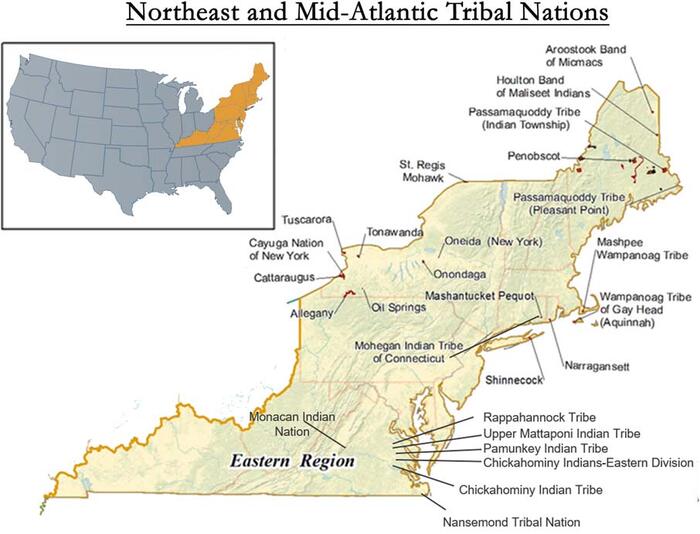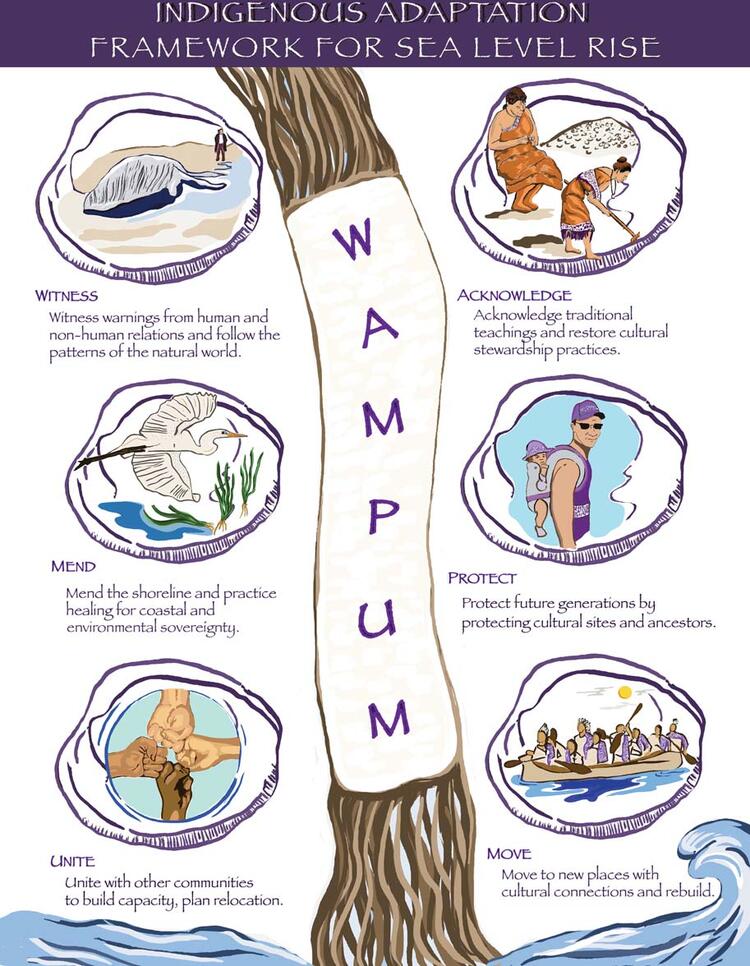Contact
Kelsey Leonard, Faculty of Environment
Canada Research Chair in Indigenous Waters, Climate and Sustainability
Introduction
Sea level rise (SLR) caused by anthropogenic climate change has increased the risk of significant environmental, social, cultural and economic impacts to coastal communities and ecosystems. Sea level rise poses particular threats to the climate and water security of northeast and mid-Atlantic Tribal Nations located along the Atlantic coast of what is currently known as the United States. Existing SLR adaptation frameworks for these areas do not include Indigenous knowledge or perspectives, prioritize economic and property rights and are misaligned with Indigenous coastal protection priorities.
Eastern coastal Tribal Nations and Indigenous communities have a unique history and ecological connection to their coastal areas and waters. If Tribal Nations are to respond effectively to SLR, adaptation frameworks must be designed and developed by Indigenous Peoples for Indigenous Peoples. The focus of this viewpoint article was to provide a new framework for Indigenous adaption measures to SLR that advance Indigenous water security based on eastern coastal Indigenous knowledge systems and ways of knowing.
Methodology
There are 24 Federally Recognized Tribes, and additional state recognized Tribal Nations and non-recognized Indigenous communities, in the northeast and mid-Atlantic regions of what is currently referred to as the United States (Figure 1). Given their resilient history of coastal management and continued stewardship of the area, this region was chosen to examine SLR impacts and adaptation frameworks.

Figure 1: Northeastern and Mid-Atlantic Tribal Nations
Indigenous scholars and others have noted how Indigenous adaptive capacity is often misinterpreted through the lens of western colonial frameworks that fail to account for Indigenous knowledge and innovation. Dismantling colonial power structures in coastal management requires new SLR adaptation strategies that are not only inclusive of, but designed by, Indigenous Peoples. The article presents a decolonial and Indigenist SLR adaptation framework that unifies Indigenous knowledge systems and experiences of northeastern and mid-Atlantic coastal Tribal Nations.
Outcomes
Most of the northeast and mid-Atlantic Tribal Nations have territory within the low-elevation coastal zone and face severe water security threats to due climate change and SLR. Population growth in the past century has exacerbated SLR vulnerabilities as available livable land continues to decrease. With increased extreme high tides and storms, Tribal Nations are currently experiencing greater levels of flooding, erosion and saltwater intrusion impacting water resources and infrastructure. Tribal Nations face many political and legal obstacles to relocation and acquisition of new lands for SLR adaptation. If climate change projections are accurate, most existing Tribal territories and reservations will be inundated and likely unlivable in the next century.
Sea level rise adaptation measures in non-Indigenous communities are generally developed in response to the risks and economic hardships imposed by climate change. Three key aspects of western colonial ethnocentrism that limit the use of existing adaptation frameworks for Indigenous Peoples are: (1) western property law systems exclude Indigenous owners; (2) market and economic valuations commodify the natural world solely for human benefit; and (3) settler-colonial individualism undermines Indigenous nationhood, kinship and sovereignty. There are no current frameworks that integrate eastern Atlantic coastal Indigenous knowledge or incorporate socio-cultural valuations.
The proposed WAMPUM Adaptation Framework for Sea Level Rise (Figure 2) builds on lessons of eastern coastal Tribal Nations SLR risks and suggests adaptation measures that are guided by Indigenous knowledge systems. Wampum refers to carved quahog and whelk shells harvested by Indigenous Nations along the Atlantic coast and used throughout history as currency and to form treaty relationships between Indigenous and settler peoples. Wampum forms the foundation of historical and contemporary understandings of sustainability for many Indigenous Nations. The WAMPUM adaptation framework synthesizes current adaptation measures implemented by northeastern and mid-Atlantic Tribal Nations and provides general adaptation principles of Witness, Acknowledge, Mend, Protect, Unite and Move.

Figure 2: WAMPUM: Indigenous adaptation framework for sea level rise
Witness
Indigenous knowledge embodies “careful, respectful observation and cooperation with natural systems for a sustainable future”. Determination of SLR adaptation measures should therefore be informed by witnessing and observing the natural world.
Acknowledge
Many Tribal Nations have traditional ecological knowledge of SLR as their communities have occupied areas now covered by water. Traditional knowledge holders should be included in the development and implementation of SLR adaptation plans created by Tribal Nations. Traditional teachings and practices can be combined, if appropriate, with other scientific measures for blended approaches.
Mend
Contemporary adaptation measures of many northeast and mid-Atlantic Tribal Nations work to mend the shoreline and coastal areas through cultural and ceremonial practices that promote healing and ecosystem rehabilitation in contrast to western adaptation frameworks that often rely on “hard” infrastructure solutions.
Protect
Indigenous water security includes the protection of cultural sites and ceremonial practices. This is integral to Indigenous SLR adaptation not only because it advances Indigenous water justice, but because it also ensures the preservation of eastern Tribal Nation history, culture, and ceremonial practices for future generations.
Unite
Among the Tribal Nations there is a common philosophy of “We Move Together” or collective action. It also describes the collective nature of decision making through clan networks within social ecological areas. These traditional kinship networks can be reconstituted to dismantle past colonial disenfranchisement as Tribal Nations work collaboratively to build capacity and unite their communities to address SLR, climate change and water injustices.
Move
Historically, Tribal Nations had numerous village sites and territorial areas that allowed communities to adapt to climatic changes and, when necessary, move often inhabiting certain areas on a seasonal basis. Current population densities and colonial policies have stolen Indigenous lands making land availability and affordability to retreat or relocate nearly impossible. Legislation and funding assistance that supports Tribal Nation relocation is required to preserve cultural connections and stewardship practices for ancestral homelands.
Conclusions
The combination of climate and water injustices facing Tribal Nations in coastal areas requires the development of more robust and culturally informed SLR adaptation frameworks that are reflective of the communities implementing the adaptation measures. Experiences of eastern Atlantic coastal Tribal Nations demonstrate a long history of innovative coastal stewardship practices and adaptation response strategies that are not reflected in existing frameworks.
The WAMPUM framework is a model and call to action for scientists, researchers, and Indigenous nations to reject oppressive and colonial adaptation frameworks and develop their own decolonial Indigenist frameworks that use Indigenous knowledge systems to build resilience and water security in the face of climate change. The framework introduces a unique set of adaptation principles (Witness, Acknowledge, Mend, Protect, Unite, and Move) reflective of Indigenous resilience over millennia in Atlantic coastal areas that can guide international, national, and regional adaptation efforts in the future.
Additional studies that are Indigenous-led and co-developed with Tribal Nations are needed to test application of the proposed adaptation framework and to explore additional climate change impacts on Tribal Nations in eastern Atlantic coastal regions.
Leonard, Kelsey (2021). WAMPUM Adaptation framework: eastern coastal Tribal Nations and sea level rise impacts on water security. Climate and Development, Volume 13, January 2021. https://doi.org/10.1080/17565529.2020.1862739
For more information about WaterResearch, contact Julie Grant.
Photo by frank mckenna on Unsplash








